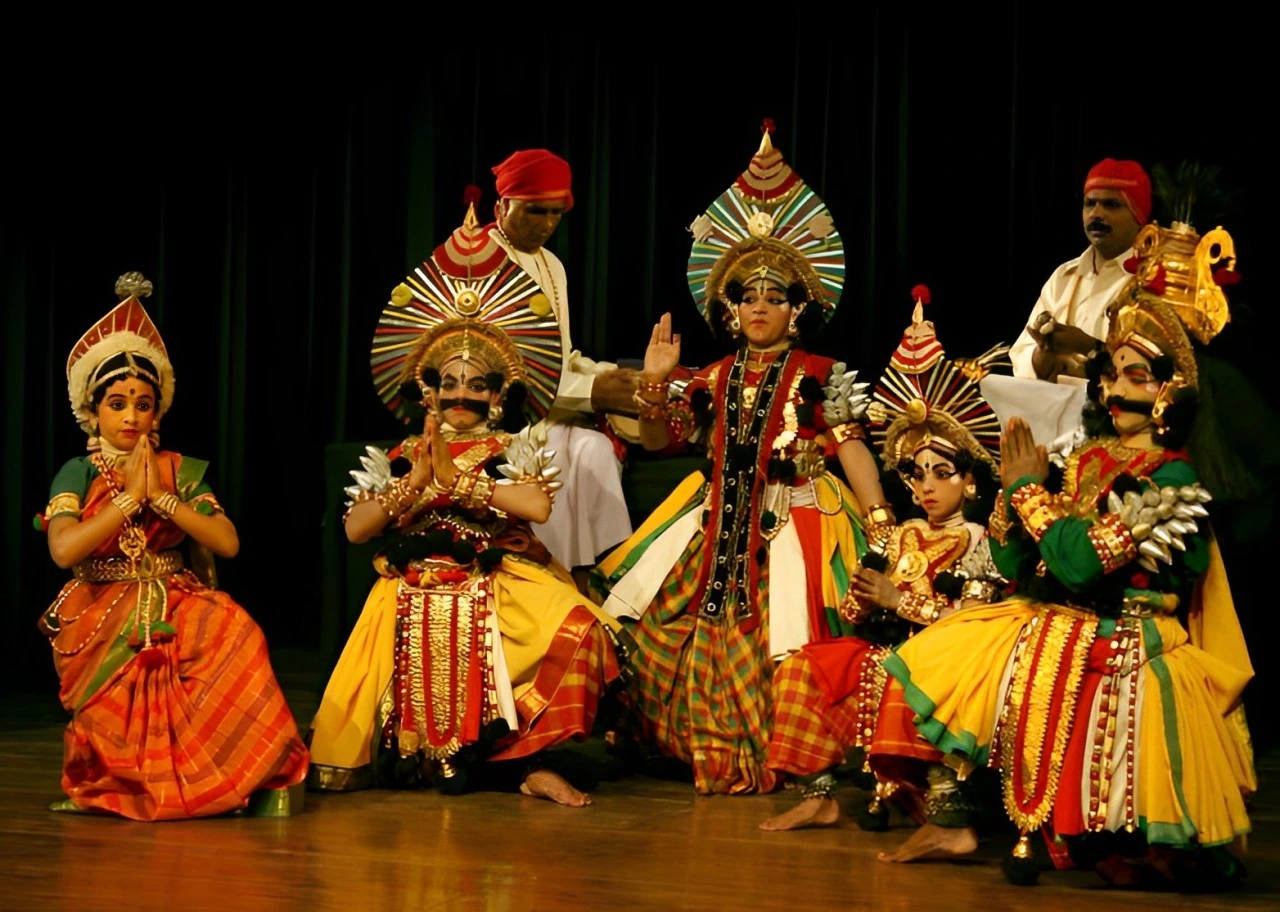Ever read or heard about Yakshagana? Most probably you haven’t caught the trace of it yet, but there is nothing that needs to be worried about because after reading out this blog post, you are going to feed up everything important related to this art form.
Table of Contents

Overview of Yakshagana
It’s shaping up to be a universal acceptance that the craze and influence of South Indian cinema, culture, food, and even all of South India have been plotting the graphs that are at their peak, both domestically and internationally, with each passing day. South India is a land of vast spectrum encompassing diverse cultures and vibrant traditions that intensify the rich tapestry of art forms, whose impact can be addressed in its cinema as well.
One of the most important art forms that is cemented as a crucial cultural pillar is a traditional theatre rooted in Karnataka named Yakshagana. Yes, it is not just a mere art form but holds the essence that moulds the narrative and aesthetic elements of South Indian cinema. Today with this blog post let’s take a glimpse of the historical origin as well as the contemporary role of Yakshagana. So, let’s start the pitch!
Ancient Roots of Yakshagana
It is a historical art form of theatre that emerged back in the 16th century. The meaning of Yakshagana is songs of celestial beings. Yakshagana emerged as a temple art form, which was used to narrate the tales from the epics, scriptures, etc., like the Mahabharata and Ramayana. The performances of this art form take place in an open-air space under a sky full of stars. Apart from this, Yakshagana is an art form that is a blend of dance, dialogue, and music.
This theatrical art form confers the inclusion of exquisite costumes, stunning characters, and stylized expressions, which were not just a source of entertainment; rather, they were a spiritual offering to the gods and goddesses. As the time passed, this religious ritual picked up a form of theatrical art. This art form later developed into the cultural identity of Karnataka, captivating the hearts of audiences. Now, let’s take a look at its impact on South Indian cinema.

Yakshagana’s Effect from Temple to Silver Screen
Theatrical Tale-Spinning
Yakshagana is particularly recognized for its powerful narrative style that is made out of the enthralling heroes, moral conflicts, and divine interventions that cavernously align with South Indian cinema. Its influence can clearly be seen in the dramatic storytelling technique of movies. The movies have picked up the grandeur of depicting the epic tales of mythology and spirituality. Its presence can be seen in movies like Narthanasala (Telugu) and Bhakta Prahlada (Kannada).
Vibrant Visual Feast
Yakshagana has also helped in adding the visually rich cinematic aesthetics into the South Indian movies. With its stunning costumes and makeup, this art form has ensured the authenticity of its visually rich portrayal of genres like fantasy and mythology. Its effect can be seen in movies directed by B. R. Panthulu and Rajkumar.
Music, Dialogue & Characterization
It is especially renowned for its idiosyncratic musical style followed by the inclusion of traditional instruments. This distinct feature of art form has helped filmmakers with lyrical compositions and scriptwriting of movies. It has been seen that in order to weave out the aspirational and relatable stories, South Indian cinema often picks up the characters of Yakshagana, like heroic kings, vengeful demons, wise sages, etc. Its expressions and symbolic gestures have augmented the on-screen performances.
Cultural Resonance in Present
Despite technological advancements and contemporary changes, it is a cherished tradition that spans centuries, connecting our roots to the future. Its presence in South Indian cinema reflects the endurance of connecting our youth with their ancestral legacy.
Modern South Indian movies like Kantara, directed by Rishab Shetty, perfectly highlighted the contemporary cultural significance through the blend of traditional art forms and modern storytelling. Apart from cinemas, Yakshagana is an emblem of cultural pride in South India.
Conclusion
Hence, it can be concluded that it is not just a theatrical art form; rather, it is a dynamic manifestation of South India’s artistic and cultural excellence. By portraying the impeccable and eternal legacy of Yakshagana, South Indian cinema is breaking barriers and making new ways where ethnic art finds new expressions in contemporary mediums.
Thus, it’s a matter of great pride for us that we nurture our roots and take them with us, wherever we go!
Read about movies influenced by Yakshagana: Kantara movie
To know more, visit here: Yakshagana – Wikipedia






